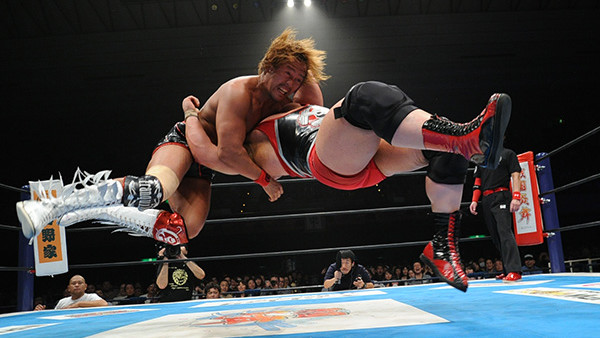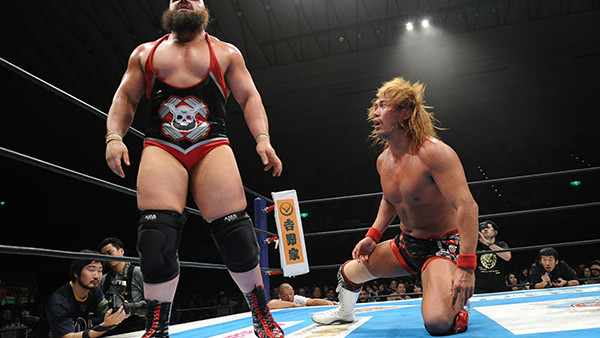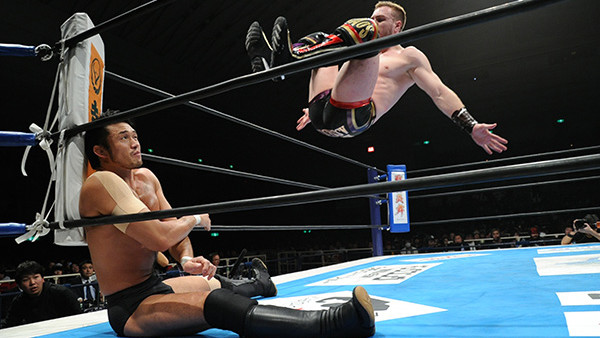NJPW The New Beginning In Osaka Review
In which too much still wasn’t quite enough.

The New Beginning In Sapporo was a one-match show.
The (arguably unnecessary) Osaka sequel was promoted with three major matches, and while none reached the immense level of Kazuchika Okada’s successful IWGP Heavyweight Title defence opposite Minoru Suzuki, all three delivered. On that basis, the show was a success - but bad habits were not limited to the protracted schedule.
Michael Elgin failed to capture Tetsuya Naito’s IWGP Intercontinental Title in a gripping headliner. The 36:17 match went at least five minutes too long - even ten - but when it was was good, it was absolutely blinding. The match followed the expected narrative pattern. Naito, faced with a much larger opponent intent on avenging the orbital bone he was credited in storylines with fracturing, worked it over in conjunction with Elgin’s equally weakened left knee. He also spat in it throughout, adding insult to literal injury, underscoring his credentials as the most despicable heel in all of wrestling.
That narrative was subverted constantly; the trademark reversal sequences that the best golden era New Japan main events excel at were performed beautifully, ensuring a rising and ceaseless crescendo of crowd heat. Towards the finish, Naito attempted to drop Elgin with a top rope Frankensteiner. Elgin caught him mid-flight, but Naito reversed the jumping powerbomb counter with a brutal mid air and reverse Frankensteiner double hit.
For thirty minutes, everything which occurred in the first five minutes had some bearing on the last. One choice motif saw Elgin attempt to floor Naito with a lariat throughout. The damage to his knee - which, incidentally, was sold superbly - meant that he could not lift Naito off his feet. When he did, the place erupted. Elgin was received as the future IWGP Heavyweight Title contender he performed as. If nothing else, The New Beginning events elevated him considerably - even in defeat.
It was beautiful in its simplicity, but the match stretched suspension of disbelief in the last five minutes. Naito endured an apron powerbomb and a brutal buckle bomb into the exposed guardrail. The impact was sickening. Naito’s head snapped backwards and back into position with impossible physics - but it wasn’t the finish. He recovered to plant Elgin with a third Destino to win. It read as if Elgin and Naito felt the need to imitate what a main event finish should look like - but the storytelling and psychology were incredible throughout. It didn’t need self-conscious add-ons. Elgin, towards the finish, mimicked Naito’s trademark open-eyed taunt as a mind game, signalling his recovery. It was visual poetry - stretched out needlessly to the length of an epic novel.

It was sensational, but it could have been even better. That was the story of both New Beginning shows. Ironically, if it was positioned in the semi-final slot of a hypothetical, combined New Beginning card, it would have benefitted from a shorter duration.
In the actual Osaka semi-final, Hiromu Takahashi also indulged in overkill during his successful IWGP Junior Heavyweight Title defence, in which he somehow didn’t paralyse challenger Dragon Lee. He gained the advantage in the middle stretch by leaping over Lee and delivering a sick sunset flip powerbomb from apron to entrance ramp. He was, to his credit, as willing to absorb punishment as he was to inflict it; Lee answered that by sending him flying with Frankensteiner off the apron. In a match built on mutual, lingering hatred, Takahashi’s sadism was not confined to his arsenal. He attempted to remove Lee’s mask throughout, in response to losing his own during their series in CMLL, and used that distraction to drill him from top turnbuckle to concrete with an overhead belly-to-belly suplex. It was an insane spot in an insane match, the outcome of which was set in motion when Takahashi countered a Frankensteiner attempt with an apron powerbomb before driving Lee’s head into the guardrail with a top rope seated senton to the outside.
It was a grudge match. The violence was necessitated by the narrative. But your enjoyment of it is entirely dependent on your threshold for Takahashi’s new mode of ultra-violence - one which might even be riskier than the gruesome 1990s All Japan style because, with the pace and height reached with those aerial manoeuvres, there is even less margin for error.

The first of the promoted trilogy saw Katsuyori Shibata defeat Will Ospreay in 13:51. The hardest striker and the most flamboyant aerialist in the game adopted a less-is-more approach, to the surprise of many - and the match, structured to flatter Ospreay in defeat, was all the better for it. Shibata displayed nimble European-style chain wrestling in the early going, a strategy Ospreay countered with his frighteningly smooth high-flying game. The story of the match - essentially an interview for Ospreay’s inevitable promotion into the heavyweight ranks - was told brilliantly. He went strike for strike with The Wrestler, at one point drilling him with a forearm to the neck so stiff that even the insanely tough Shibata howled in agony. Towards the finish, he even paid tribute to John Cena’s new roll through into a power lift spot in order to underscore his prospects as a heavyweight. It was excellent storytelling from a man supposedly incapable of it.

Elsewhere, the action was decent enough, if inconsequential. In the other title bouts, the Los Ingobernables de Japon faction of BUSHI, EVIL and SANADA captured the NEVER Openweight 6-Man Tag Team Titles from Hiroshi Tanahashi, Manabu Nakanishi and Ryusuke Taguchi, marking the only switch of the night. Tomohiro Ishii and Toru Yano retained their IWGP Tag Team straps in yet another three-way match against Togi Makabe and Tomoaki Honma and Davey Boy Smith Jr. and Takashi Iizuka. Both matches were good, nothing more - but different, at least. The undercard was too short to leave much of an impression, which rendered Suzuki-gun’s face-saving wins rather pointless.
Kevin Kelly and Don Callis didn’t die a death at the announce desk, but their commentary was lifeless. Callis even used the tiresome “If you look up X in the dictionary…” cliche to describe Minoru Suzuki. Their work wasn’t awful, but it didn’t engage - hardly the best method of convincing overseas fans to commit to the still unintuitive New Japan World streaming service.
New Japan could have produced one classic card, but in dividing The New Beginning, the company diluted its buzz. In a vital year, one in which the company is intent on doubling its efforts to expand, one has to question the decision to produce shows only half as good as they could have been.